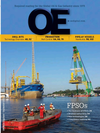
Page 41: of Offshore Engineer Magazine (Sep/Oct 2014)
Read this page in Pdf, Flash or Html5 edition of Sep/Oct 2014 Offshore Engineer Magazine
33 and 46, CFR. The regulations provide detailed guidance for compliance, DNV GL created a roadmap and a class notation the design, construction and operation of these units. (US) in the interest of the operators and engineering houses.
However, USCG has recognized that the design and technology
A matrix of requirements of offshore facilities continues to advance at a rapid pace, and that existing US regulations The document titled DNV GL SE-003,
USCG has recognized that (CFRs mentioned above) do not address the outlines a regulatory roadmap for owners current state of technology. Under 33 CFR and operators of FOI, FPSO and FSO units design and technology 143.120, the USCG has the authority to accept wishing to engage in OCS activities in the of offshore facilities alternative design and engineering standards US Gulf of Mexico. The roadmap uses DNV continues to advance at if an equivalent level of safety is provided. GL classi? cation rules and services as a
Accordingly, the USCG published CG-ENG building block, and identi? es additional a rapid pace, and that
Policy Letter No. 01-13, which prescribes USCG design and equipment requirements existing US regulations do alternate design and equipment standards for these units that are not otherwise cov- not address the current for ? oating offshore installations (FOI) and ered by the rules. state of technology. ? oating production, storage, and of? oading Compliance with the appropriate DNV offshore units (FPSO) located on the US OCS. In general, the GL classi? cation notations and supplemental USCG design and policy letter requires the ? oating unit to be classed by a classi? ca- equipment requirements described in this service speci? cation tion society (DNV GL, ABS and Lloyd’s Register) that is accepted provides an equivalent level of safety to the USCG’s design and by the USCG, and establishes requirements to be met in addition equipment requirements prescribed in the CFR. to the classi? cation society’s rules.
Contents of the document
A ? oating facility meeting the design and construction require- ments of this policy letter is considered meet a level of safety The document outlines a DNV GL class-based veri? cation equivalent to that prescribed by 33 CFR 143. scheme for US compliance for offshore objects of the following types: FOI, FSO, and FPSOs.The document is divided into two
Objective of the regulatory roadmap main chapters and an appendix:
Ch.1: General information about principles, procedures and
As there are differences in the class society rules, which • legal provisions for meeting an equivalent level of safety form the basis of the equivalencies, and the complementing requirements from the CFR, there remained an uncertainty to the USCG requirements (as documented in their policy letter No. 1-13) for FOIs, FSOs and FPSOs meant to operate on the requirements and the ? nal approvals. To remove this
ABBTC_ADL2HP_SE_INVEST_OE 12.08.14 17:05 Seite 1 uncertainty factor and in order to establish a clear path of on the US OCS.
Turbocharging Service.
Secure your investment.
Assuring the availability of your application is a critical part of securing your business.
The right service reduces downtimes and increases your application’s performance and lifetime. Getting your service plan from ABB Turbocharging guarantees depend- able delivery of results and lower total cost of ownership of your turbocharger. We are dedicated to providing our customers a comprehensive turbocharging service offer- ing 24/7, 365 days a year at any one of our 100+ ABB-owned Service Stations in 50+ countries across the globe. Get the right service. www.abb.com/turbocharging oedigital.com September 2014 | OE 43 042_OE0914_FPSO4_DNV.indd 43 8/21/14 3:04 PM

 40
40

 42
42